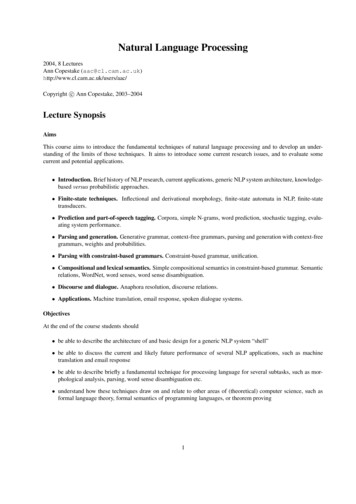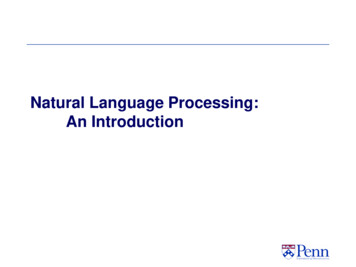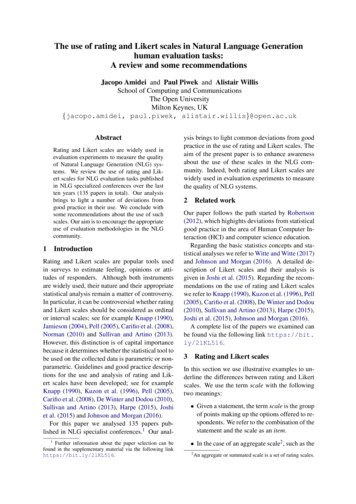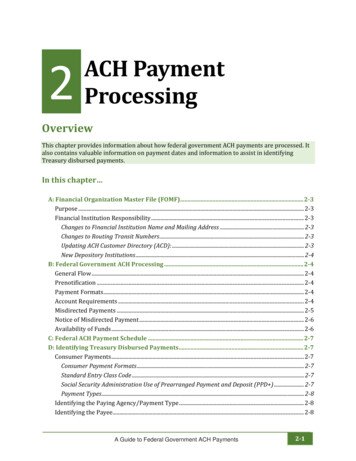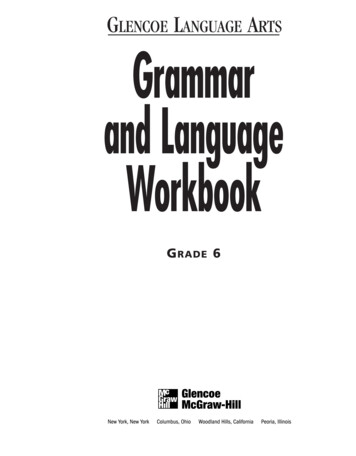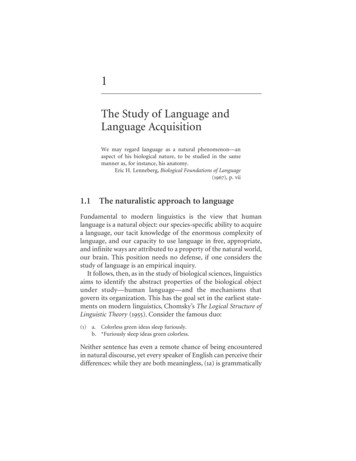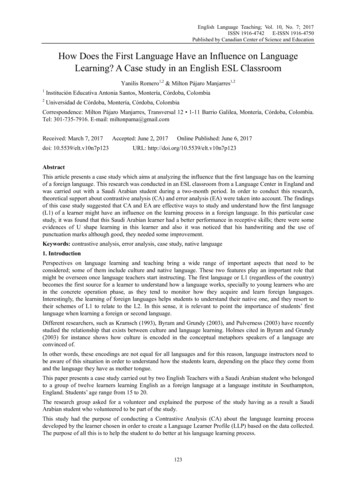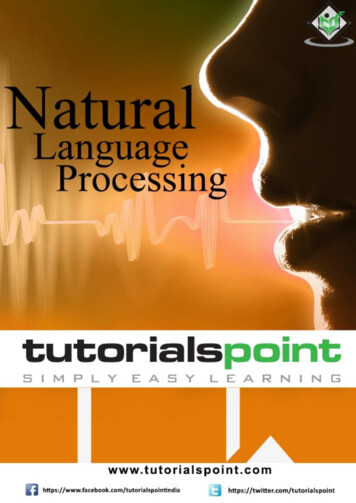
Transcription
Natural Language Processingi
Natural Language ProcessingAbout the TutorialLanguage is a method of communication with the help of which we can speak, read andwrite. Natural Language Processing (NLP) is a subfield of Computer Science that deals withArtificial Intelligence (AI), which enables computers to understand and process humanlanguage.AudienceThis tutorial is designed to benefit graduates, postgraduates, and research students whoeither have an interest in this subject or have this subject as a part of their curriculum.The reader can be a beginner or an advanced learner.PrerequisitesThe reader must have basic knowledge about Artificial Intelligence. He/she should also beaware about basic terminologies used in English grammar and Python programmingconcepts.Copyright & Disclaimer Copyright 2019 by Tutorials Point (I) Pvt. Ltd.All the content and graphics published in this e-book are the property of Tutorials Point (I)Pvt. Ltd. The user of this e-book is prohibited to reuse, retain, copy, distribute or republishany contents or a part of contents of this e-book in any manner without written consentof the publisher.We strive to update the contents of our website and tutorials as timely and as precisely aspossible, however, the contents may contain inaccuracies or errors. Tutorials Point (I) Pvt.Ltd. provides no guarantee regarding the accuracy, timeliness or completeness of ourwebsite or its contents including this tutorial. If you discover any errors on our website orin this tutorial, please notify us at contact@tutorialspoint.comi
Natural Language ProcessingTable of ContentsAbout the Tutorial . iAudience . iPrerequisites . iCopyright & Disclaimer . iTable of Contents . ii1.Natural Language Processing – Introduction . 1History of NLP . 1Study of Human Languages . 2Ambiguity and Uncertainty in Language . 3NLP Phases. 52.Natural Language Processing — Linguistic Resources . 7Corpus . 7Elements of Corpus Design . 7TreeBank Corpus . 8Types of TreeBank Corpus . 9Applications of TreeBank Corpus . 9PropBank Corpus . 9VerbNet(VN) . 10WordNet . 103.Natural Language Processing — Word Level Analysis. 11Regular Expressions . 11Properties of Regular Expressions . 11Examples of Regular Expressions . 12Regular Sets & Their Properties. 12Finite State Automata. 13Relation between Finite Automata, Regular Grammars and Regular Expressions . 13ii
Natural Language ProcessingTypes of Finite State Automation (FSA) . 14Morphological Parsing . 16Types of Morphemes . 174.Natural Language Processing — Syntactic Analysis . 19Concept of Parser . 19Types of Parsing . 19Concept of Derivation. 20Types of Derivation. 20Concept of Parse Tree . 20Concept of Grammar . 20Phrase Structure or Constituency Grammar . 21Dependency Grammar . 22Context Free Grammar . 23Definition of CFG . 245.Natural Language Processing — Semantic Analysis . 25Elements of Semantic Analysis . 25Difference between Polysemy and Homonymy . 26Meaning Representation . 26Approaches to Meaning Representations . 27Need of Meaning Representations . 27Lexical Semantics . 276.Natural Language Processing — Word Sense Disambiguation . 29Evaluation of WSD . 29Approaches and Methods to Word Sense Disambiguation (WSD) . 30Applications of Word Sense Disambiguation (WSD) . 30Difficulties in Word Sense Disambiguation (WSD) . 317.Natural Language Processing — Discourse Processing . 33Concept of Coherence . 33iii
Natural Language ProcessingDiscourse structure . 33Algorithms for Discourse Segmentation . 33Text Coherence. 34Building Hierarchical Discourse Structure . 35Reference Resolution . 35Terminology Used in Reference Resolution . 36Types of Referring Expressions . 36Reference Resolution Tasks . 378.Natural Language Processing — Part of Speech (PoS) Tagging . 38Rule-based POS Tagging . 38Properties of Rule-Based POS Tagging . 38Stochastic POS Tagging . 39Properties of Stochastic POS Tagging . 39Transformation-based Tagging . 39Working of Transformation Based Learning (TBL) . 40Advantages of Transformation-based Learning (TBL) . 40Disadvantages of Transformation-based Learning (TBL) . 40Hidden Markov Model (HMM) POS Tagging . 40Hidden Markov Model . 40Use of HMM for POS Tagging . 429.Natural Language Processing — Natural Language Inception . 44Natural Language Grammar . 44Components of Language . 44Grammatical Categories . 45Spoken Language Syntax . 4810. Natural Language Processing — Information Retrieval . 49Classical Problem in Information Retrieval (IR) System. 49Aspects of Ad-hoc Retrieval . 50iv
Natural Language ProcessingInformation Retrieval (IR) Model. 50Types of Information Retrieval (IR) Model . 50Design features of Information retrieval (IR) systems . 51The Boolean Model . 51Advantages of the Boolean Model . 52Disadvantages of the Boolean Model. 52Vector Space Model . 52Cosine Similarity Measure Formula . 53Vector Space Representation with Query and Document . 53Term Weighting . 54Forms of Document Frequency Weighting . 54User Query Improvement . 55Relevance Feedback . 5511. Natural Language Processing — Applications of NLP. 57Types of Machine Translation Systems . 59Approaches to Machine Translation (MT) . 59Fighting Spam . 60Existing NLP models for spam filtering . 60Automatic Summarization . 61Question-answering . 61Sentiment Analysis . 6112. Natural Language Processing — Language Processing and Python . 62Prerequisites . 62Getting Started with NLTK . 62Downloading NLTK’s Data . 63Other Necessary Packages. 63Tokenization . 64Stemming . 64v
Natural Language ProcessingLemmatization . 65Counting POS Tags – Chunking . 66Running the NLP Script . 66vi
1. Natural Language Processing — IntroductionNatural Language ProcessingLanguage is a method of communication with the help of which we can speak, read andwrite. For example, we think, we make decisions, plans and more in natural language;precisely, in words. However, the big question that confronts us in this AI era is that canwe communicate in a similar manner with computers. In other words, can human beingscommunicate with computers in their natural language? It is a challenge for us to developNLP applications because computers need structured data, but human speech isunstructured and often ambiguous in nature.In this sense, we can say that Natural Language Processing (NLP) is the sub-field ofComputer Science especially Artificial Intelligence (AI) that is concerned about enablingcomputers to understand and process human language. Technically, the main task of NLPwould be to program computers for analyzing and processing huge amount of naturallanguage data.History of NLPWe have divided the history of NLP into four phases. The phases have distinctive concernsand styles.First Phase (Machine Translation Phase) – Late 1940s to late 1960sThe work done in this phase focused mainly on machine translation (MT). This phase wasa period of enthusiasm and optimism.Let us now see all that the first phase had in it: The research on NLP started in early 1950s after Booth & Richens’ investigationand Weaver’s memorandum on machine translation in 1949. 1954 was the year when a limited experiment on automatic translation fromRussian to English demonstrated in the Georgetown-IBM experiment. In the same year, the publication of the journal MT (Machine Translation) started. The first international conference on Machine Translation (MT) was held in 1952and second was held in 1956. In 1961, the work presented in Teddington International Conference on MachineTranslation of Languages and Applied Language analysis was the high point of thisphase.Second Phase (AI Influenced Phase) – Late 1960s to late 1970sIn this phase, the work done was majorly related to world knowledge and on its role in theconstruction and manipulation of meaning representations. That is why, this phase is alsocalled AI-flavored phase.The phase had in it, the following:1
Natural Language Processing In early 1961, the work began on the problems of addressing and constructing dataor knowledge base. This work was influenced by AI. In the same year, a BASEBALL question-answering system was also developed.The input to this system was restricted and the language processing involved wasa simple one. A much advanced system was described in Minsky (1968). This system, whencompared to the BASEBALL question-answering system, was recognized andprovided for the need of inference on the knowledge base in interpreting andresponding to language input.Third Phase (Grammatico-logical Phase) – Late 1970s to late 1980sThis phase can be described as the grammatico-logical phase. Due to the failure ofpractical system building in last phase, the researchers moved towards the use of logic forknowledge representation and reasoning in AI.The third phase had the following in it: The grammatico-logical approach, towards the end of decade, helped us withpowerful general-purpose sentence processors like SRI’s Core Language Engineand Discourse Representation Theory, which offered a means of tackling moreextended discourse. In this phase we got some practical resources & tools like parsers, e.g. AlveyNatural Language Tools along with more operational and commercial systems, e.g.for database query. The work on lexicon in 1980s also pointed in the direction of grammatico-logicalapproach.Fourth Phase (Lexical & Corpus Phase) – The 1990sWe can describe this as a lexical & corpus phase. The phase had a lexicalized approach togrammar that appeared in late 1980s and became an increasing influence. There was arevolution in natural language processing in this decade with the introduction of machinelearning algorithms for language processing.Study of Human LanguagesLanguage is a crucial component for human lives and also the most fundamental aspectof our behavior. We can experience it in mainly two forms – written and spoken. In thewritten form, it is a way to pass our knowledge from one generation to the next. In thespoken form, it is the primary medium for human beings to coordinate with each other intheir day-to-day behavior. Language is studied in various academic disciplines. Eachdiscipline comes with its own set of problems and a set of solution to address those.2
Natural Language ProcessingConsider the following table to understand this:DisciplineProblemsToolsLinguistsHow phrases and sentences canbe formed with words?Intuitions about well-formednessand meaning.What curbs the possible meaningfor a sentence?Mathematical model of structure.For example, model theoreticsemantics,formallanguagetheory.How human beings can identifythe structure of sentences?Experimental techniques mainlyfor measuring the performance ofhuman beings.PsycholinguistsHow the meaning of words can beidentified?Statistical analysis of observations.When does understanding takeplace?PhilosophersHow do words and sentencesacquire the meaning?Natural language argumentationby using intuition.How the objects are identified bythe words?Mathematical models like logic andmodel theory.What is meaning?ComputationalLinguistsHow can we identify the structureof a sentenceHow knowledge and reasoningcan be modeled?How we can use language toaccomplish specific tasks?AlgorithmsData structuresFormal models of representationand reasoning.AI techniques like searchrepresentation methods.&Ambiguity and Uncertainty in LanguageAmbiguity, generally used in natural language processing, can be referred as the ability ofbeing understood in more than one way. In simple terms, we can say that ambiguity isthe capability of being understood in more than one way. Natural language is veryambiguous. NLP has the following types of ambiguities:Lexical AmbiguityThe ambiguity of a single word is called lexical ambiguity. For example, treating the wordsilver as a noun, an adjective, or a verb.Syntactic AmbiguityThis kind of ambiguity occurs when a sentence is parsed in different ways. For example,the sentence “The man saw the girl with the telescope”. It is ambiguous whether the mansaw the girl carrying a telescope or he saw her through his telescope.3
Natural Language ProcessingSemantic AmbiguityThis kind of ambiguity occurs when the meaning of the words themselves can bemisinterpreted. In other words, semantic ambiguity happens when a sentence contains anambiguous word or phrase. For example, the sentence “The car hit the pole while it wasmoving” is having semantic ambiguity because the interpretations can be “The car, whilemoving, hit the pole” and “The car hit the pole while the pole was moving”.Anaphoric AmbiguityThis kind of ambiguity arises due to the use of anaphora entities in discourse. For example,the horse ran up the hill. It was very steep. It soon got tired. Here, the anaphoric referenceof “it” in two situations cause ambiguity.Pragmatic ambiguitySuch kind of ambiguity refers to the situation where the context of a phrase gives itmultiple interpretations. In simple words, we can say that pragmatic ambiguity ariseswhen the statement is not specific. For example, the sentence “I like you too” can havemultiple interpretations like I like you (just like you like me), I like you (just like someoneelse dose).4
Natural Language ProcessingNLP PhasesFollowing diagram shows the phases or logical steps in natural language processing:Input formationPragmaticanalysisTarget representationMorphological ProcessingIt is the first phase of NLP. The purpose of this phase is to break chunks of language inputinto sets of tokens corresponding to paragraphs, sentences and words. For example, aword like “uneasy” can be broken into two sub-word tokens as “un-easy”.Syntax AnalysisIt is the second phase of NLP. The purpose of this phase is two folds: to check that asentence is well formed or not and to break it up into a structure that shows the syntacticrelationships between the different words. For example, the sentence like “The schoolgoes to the boy” would be rejected by syntax analyzer or parser.Semantic Analysis5
Natural Language ProcessingIt is the third phase of NLP. The purpose of this phase is to draw exact meaning, or youcan say dictionary meaning from the text. The text is checked for meaningfulness. Forexample, semantic analyzer would reject a sentence like “Hot ice-cream”.Pragmatic AnalysisIt is the fourth phase of NLP. Pragmatic analysis simply fits the actual objects/events,which exist in a given context with object references obtained during the last phase(semantic analysis). For example, the sentence “Put the banana in the basket on the shelf”can have two semantic interpretations and pragmatic analyzer will choose between thesetwo possibilities.6
2. Natural Language Processing — LinguisticResourcesNatural Language ProcessingIn this chapter, we will learn about the linguistic resources in Natural Language Processing.CorpusA corpus is a large and structured set of machine-readable texts that have been producedin a natural communicative setting. Its plural is corpora. They can be derived in differentways like text that was originally electronic, transcripts of spoken language and opticalcharacter recognition, etc.Elements of Corpus DesignLanguage is infinite but a corpus has to be finite in size. For the corpus to be finite in size,we need to sample and proportionally include a wide range of text types to ensure a goodcorpus design.Let us now learn about some important elements for corpus design:Corpus RepresentativenessRepresentativeness is a defining feature of corpus design. The following definitions fromtwo great researchers – Leech and Biber, will help us understand corpusrepresentativeness: According to Leech (1991), “A corpus is thought to be representative of thelanguage variety it is supposed to represent if the findings based on its contentscan be generalized to the said language variety”. According to Biber (1993), “Representativeness refers to the extent to which asample includes the full range of variability in a population”.In this way, we can conclude that representativeness of a corpus are determined by thefollowing two factors: Balance – The range of genre include in a corpus. Sampling – How the chunks for each genre are selected.Corpus BalanceAnother very important element of corpus design is corpus balance – the range of genreincluded in a corpus. We have already studied that representativeness of a general corpusdepends upon how balanced the corpus is. A balanced corpus covers a wide range of textcategories, which are supposed to be representatives of the language. We do not haveany reliable scientific measure for balance but the best estimation and intuition works inthis concern. In other words, we can say that the accepted balance is determined by itsintended uses only.Sampling7
Natural Language ProcessingAnother important element of corpus design is sampling. Corpus representativeness andbalance is very closely associated with samp
learning algorithms for language processing. Study of Human Languages Language is a crucial component for human lives and also the most fundamental aspect of our behavior. We can experience it in mainly two forms – written and spoken. In the written form, it is a way to p
